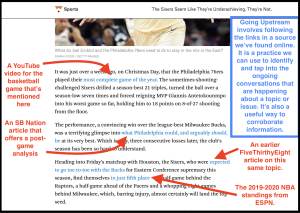6
Key Concepts
Going Upstream: a research practice used to evaluate sources found on the open web as well as identify the conversations that are happening about a given issue. Going Upstream entails locating the source of specific statements and ideas in artifacts found online by going “upstream” to the source of claims we encounter.
Lateral Reading: a research practice used to evaluate sources found on the open web, one which involves reading what other people say about the sources we find (the publication, author, etc.). It works on the premise that the truth is in the network of information we find.
In addition to some of the practices outlined in the previous chapter (“Finding A Conversation“), two other practices that can be vital to the early stages of the research process when we’re looking to understand what conversations are happening about an issue in public discourse are Going Upstream and Lateral Reading. Both of these practices are discussed in greater depth in Mike Caulfield’s Web Literacy for Student Fact Checkers.
Going Upstream
Going Upstream involves taking a piece of information on the web (say an article from a piece of online journalism) and tracking down the source of the information by noticing any references that are mentioned throughout the source and then finding those things. For instance, if we’re reading an article on The Atlantic and it mentions reporting done in The New York Times, we track down the source from The New York Times. Maybe that article from The New York Times mentions reporting done in Politico or FiveThirtyEight; next we could track that information down. Maybe the FiveThirtyEight article mentions research done by the Center for Disease Control, so we could track that down too. The neat thing about Going Upstream is that it not only helps us get a sense of what the larger conversation is about the issue we’re researching, it is also a practice that we can continue to engage in at a deeper and deeper level anytime we encounter information on the open web.
Lateral Reading
Similar to the practice of Going Upstream, Lateral Reading also involves coming to a better understanding of a source we’ve found on the open web by looking at other information (beyond our original source). Lateral Reading, however, can be particularly useful when we’re confronted with a source from the open web that we’re not familiar with. Say, for example, we find ourselves looking at a source on NPR that’s an interview conducted by Audie Cornish, and we aren’t totally sure what, exactly, NPR is. Or maybe we’re familiar with the source itself, but we’d like to learn more about the author or interviewer (so Audie Cornish, in this example). One useful practice can be to poke around on the site itself to see what we can find about the source and the author. While different sites have different naming conventions, virtually all sources found on the open web have an “About Us” section (or an equivalent section with a similar title), and if we locate that page, we can learn about what the publication says about itself. Sometimes, we can also find similar pages or blurbs on the site about the author as well.
However, while this practice of evaluating a source by staying on pages of the source itself can certainly be a valuable way to get a sense of what the source says about itself, we’re still only looking at information about the source from the source’s own angle of vision. As good researchers who are trying to get a full sense of the conversations that are happening about our issue, we know that it would benefit us to try to gather information from various stakeholders.
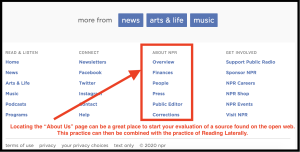
To that effect, here’s how Lateral Reading works: when we find a source on the open web, we quickly assess some of the most basic information about the source—like what the publication is and who the author is—and then open up tabs in our web browser to try to find out as much information as possible about those things, being sure to look outside of our original source. For instance, in our above example, we could do a web search for both NPR and Audie Cornish and see what we can learn about them. This is where Wikipedia can be helpful; it can provide us a broad overview of a particular publication and in many cases of a particular writer. (Yes, you read that sentence correctly! Your composition textbook just encouraged you to see value in Wikipedia, but as you’ll see there are some caveats coming up in a second.) For instance, looking at the Wikipedia entry for a source (like NPR, to stick with our example) can tell us some basic information that can help us assess its credibility or angle of vision. How long has the publication been in existence? Has it won any awards? Has it been involved in any controversies? All of this can be useful information to think about as we go back to our original source and carefully read through it to understand and evaluate it in the context of other sources that are part of the larger conversation we’re researching. Conversely, maybe we find it’s difficult to find information on the open web about our source or its author and that we have to do a lot of digging around online to find information on them. That in and of itself could be useful to know as we go back to the original source. The key thing, however, to remember when looking at sources we’ve found online is that the truth lies in the network of information, so while Wikipedia entries about specific publications or authors can give us useful information for understanding and evaluating open web sources, what’s important to remember is that those Wikipedia entries are only one piece of the larger puzzle we’re constructing when we’re trying to understand the conversation about our issue.
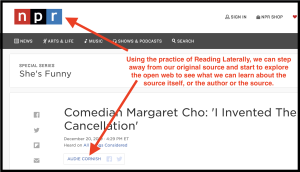
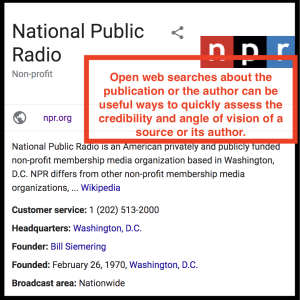
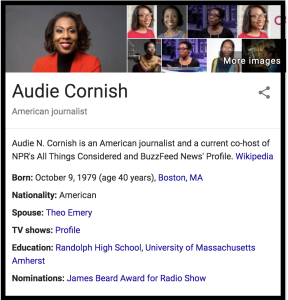
While there are distinctions between these two practices (Going Upstream and Lateral Reading), the premise behind both of them involves adopting a mindset of inquiry and viewing all information we encounter on the open web as part of a larger, ongoing conversation—a conversation we want to fully understand before we formulate our opinions.
